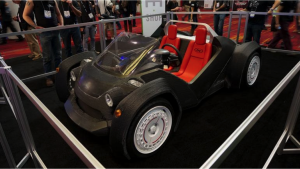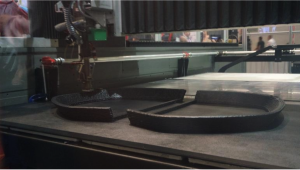3D Printing – First resin toys now cars and buildings, the only question is: When?

3D printing started producing small pieces mad of resin. With time, this technology has become commonplace and now we can buy a 3D printer in a kit for $600. We realize to what extent this technology is being incorporate in our lives when we stumble upon one of these shops that produce a mini-you printed full-color in 3D for $100. Then, suddenly, we become aware that it is becoming mainstream.
However, not all technologies have the same transformative power. Some of them, radical and disruptive innovations can destroy economic empires, change our habits and create new meanings and social constructs in a matter of years. If you are not convinced of this, look into your pockets, what do you find there? A Nokia or a Blackberry? Chances are that you use an iPhone or Android based device. Only a few years ago these companies had market shares approaching 60% or 80%. Now, who do you know that uses a Nokia?
Is 3D printing one of this?
In many ways 3D printing as an innovation process resembles previous ones such as LCD TVs, PDAs (now called smartphones), … a pattern typical of disruptive innovation. A new technology appears that beginning as a toy, after a few iterations covers 70% of our needs with a huge price gap and eventually replaces and redefines a whole sector. This has been the case of LCD with CRT, SDD with hard drives or smartphones with mobile phones and so many other examples.
Always the puzzling story is that we know the outcome, we all know it. There is little doubt that eventually the old technology is going to be replaced. Looks this familiar? Do you think it fits well the pattern of 3D printing? Probably yes.
The “what” is never the question in disruptive innovation, the only question is when, that we don’t know. And this is the case with 3D printing: when. You may wonder why the “when” is so complicated. Why companies with more than enough money, resources, time, full of clever people, committed to do the best, fail miserably and get dismantled by disruptive innovations. The answer is again simple: speed. Well probably more than speed, acceleration.
In fact the process of disruptive innovation, as many other innovation processes, is one of adoption and discovery where each part feeds the other. And this process accelerates as we dive into larger populations, then there is more money, more interest, more value to capture and more people eager to try and experiment, so adoption and discovery gain speed, a lot of it. In fact, unless there are insurmountable barriers like fast charging and long lasting batteries for example, the cycle of adoption and discovery takes so much speed that not even the larger companies have the money and resources to follow.
Is this the case with 3D printing?
This days chance has made that two news appear in the press. First Local Motors starts selling a 3D printed electric car. True is that a Renault Twizy donates its power train, suspension and steering components to the Strati, the name of the car. Along with the seats, lights, wheels and tires, these are the only bits that are not 3D-printed. And even more puzzling, Winsun a Shanghai based company prints houses up to 5 floors.
 In both case
In both case s gains are mind blowing fitting perfectly the pattern of any disruptive technology. Printing a car takes merely 44 hours and 3D printing houses saves 60% of the materials, 70% of the time and 80% of the labor compared to building a typical home.
s gains are mind blowing fitting perfectly the pattern of any disruptive technology. Printing a car takes merely 44 hours and 3D printing houses saves 60% of the materials, 70% of the time and 80% of the labor compared to building a typical home.
If we look closely, it looks like the chasm between toy products or ingenious prototypes and real products with clear advantages is being crossed without little technological barriers ahead. There is however a lot to be done but we are probably at the beginning of the acceleration curve. This is precisely the point where companies are taken by surprise because the roller coaster begins and the process accelerates to a level that only insiders are able to keep up.
Once more, like with CRT, Digital Photography or Hard drives, we know the future and now we have a glimpse of the when: soon. However, chances are that history repeats itself and we witness how the incumbents are being replaced. Once again, creative destruction at its best. Remember Nokia, Blackberry, Kodak and so many others.
